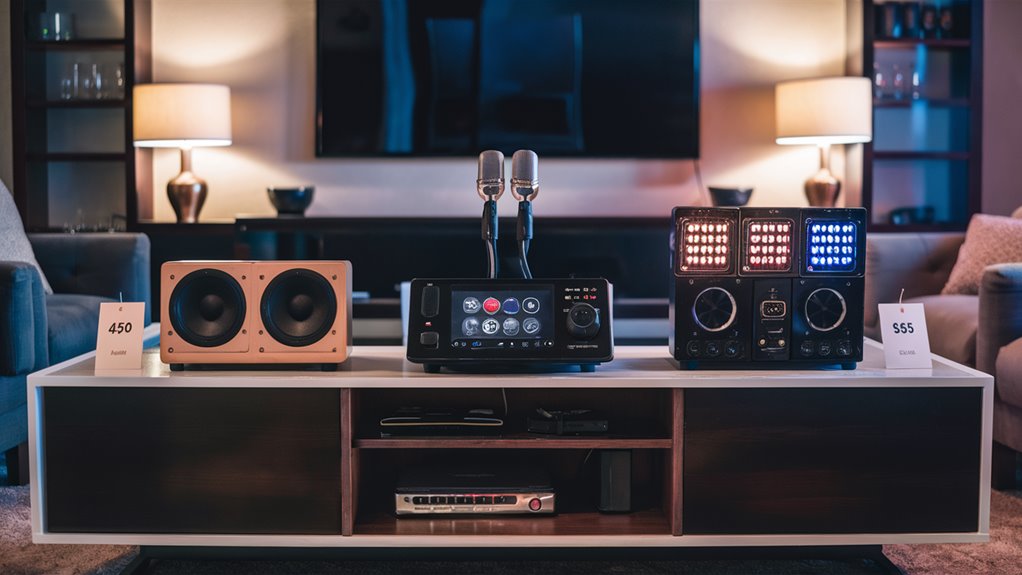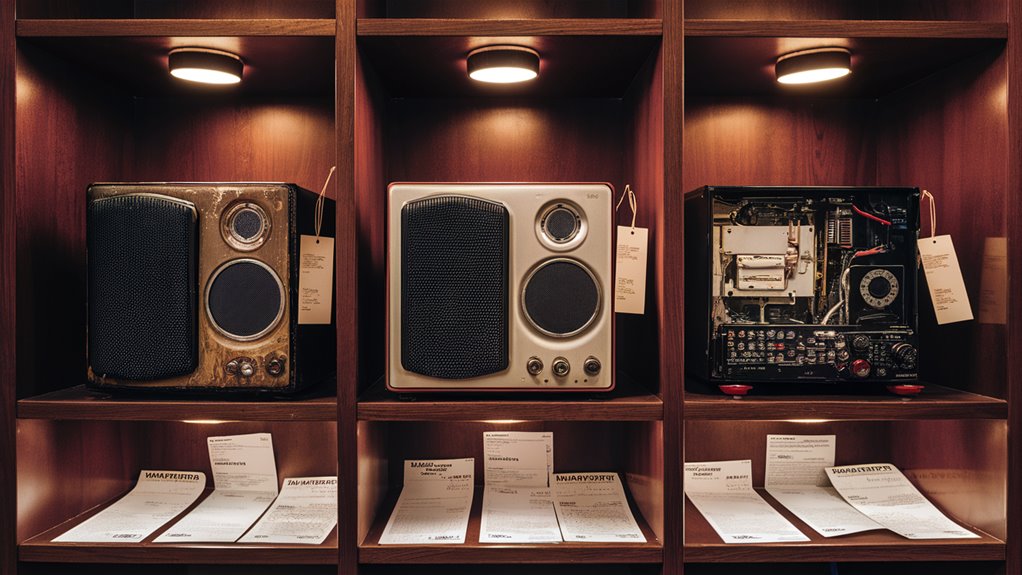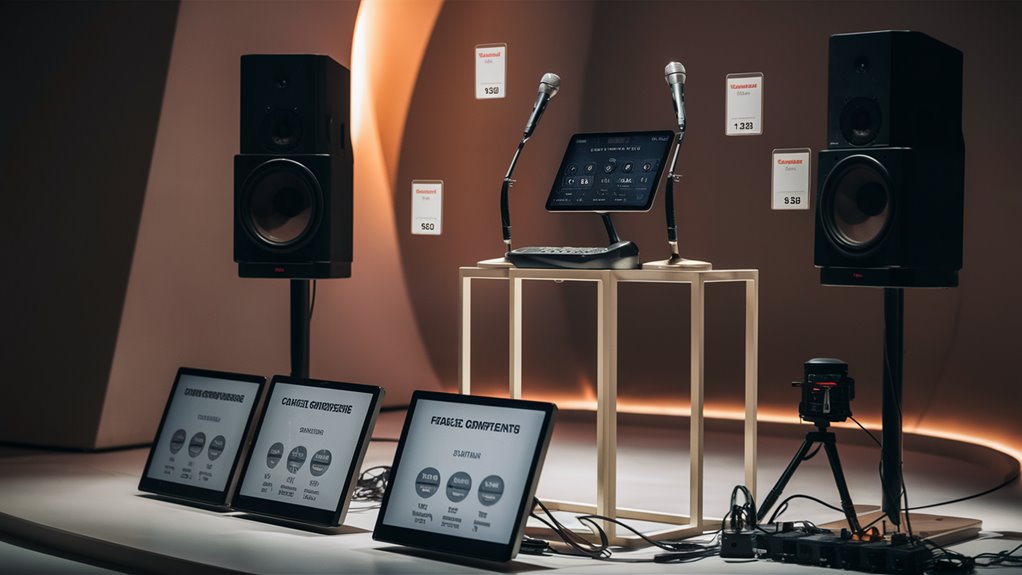
Picking the Right Karaoke System on a Budget

Know Your Budget and Needs
The search for a karaoke system starts by setting your budget range ($200-2000+) and how you plan to use it. Home karaoke setups often work best with all-in-one systems that cost $200-800, with built-in speakers and sound boost. Pro spots need more high-tech modular rack systems ($1000-3000) that can grow as needs change.
Key Tech Specs
Main Parts
- At least 100W RMS speaker power
- Two mic inputs
- 16-bit sound
- Works with many formats (MP3, CD+G, MP4)
Extra Tech
- Class D amps with under 1% THD
- Pitch can change over six half-steps
- High-grade sound range (20Hz-20kHz)
- Digital sound tweaks
- Echo and sound depth controls
Systems for Different Uses
At Home
- Compact all-in-one choices
- Options with screens
- Links without wires
- Works with phones
Pro Venues
- Setups that grow with racks
- Strong sound boost
- Lots of ways to plug in
- Top-notch sound paths
Kinds of Karaoke Setups
Getting to Know Today’s Karaoke Setup Types
Main System Groups
The latest karaoke scene shows four key system types: all-in-one units, pro rack systems, software-based setups, and streaming karaoke services.
All-In-One Karaoke Systems
All-in-one karaoke systems bring together needed parts like speakers, amps, and song storage in one small box.
These usually have 2-4 mic inputs and simple sound controls. They are easy to move but can’t be made bigger later.
Pro-Level Rack Systems
Pro karaoke rack systems use separate parts like preamps, amps, mixers, and sound effects tools.
These provide top sound quality and lots of custom options, holding 8+ mic connections and expert sound routes. Their parts can be swapped and added to.
Karaoke Software Choices
An app-based karaoke setup turns computers and phones into full karaoke systems.
This calls for outside mics and speakers but has a big song list and top tools like tone fixing and score giving. This fits users with good sound gear and tech know-how.
Streamed Karaoke Services
Streaming karaoke platforms run through apps and web pages, needing only a good net link and output tools.
These don’t need local storage but give updated song Visit more Website lists and pay-by-month access to many tracks. Users must have their own mic and speaker gear to fully use it.
Setting Your Spending Range
Setting Your Spending Limits for Karaoke Gear
Know the Price Levels
Simple All-in-One Systems: $100-300
Easy-to-use plug-and-sing karaoke units come with speakers and songs already in them.
These small boxes have basic mics and screens built-in, great for fun at home.
Mid-Level Setups: $300-800
Component setups give better sound with separate amps (50-150W), good speakers (200-300W), and mics with pro echo effects.
These give better sound and more ways to use them.
Top-End Gear: $800-2000+
Best karaoke setups have power mixers (300W+), UHF dual wireless mics, and pro speakers (500W+).
They also have pay-for song lists and all the sound controls you could want.
Extra Costs to Think About
Needed Extras
- Spare batteries: $150-300
- Best wires and stands: $50-100
- Month-by-month song list updates: $15-30
Plan for Future Spending
Put aside 10-15% of the total money for system growth and new parts.
This plan lets you add new tech easily without having to buy a whole new system.
Parts Worth Your Money
Core Parts to Spend On in Karaoke Systems

Main Sound Parts
Digital sound work needs to be 16-bit or more. It’s a must for pro systems.
Built-in echo and voice boosts make sure the sound is clear and as good as a studio.
Connecting Well
Two mic inputs with their own sound levels let two people sing well together and mix the sound right.
Good systems can handle different file types like MP3, CD+G, and MP4, and link up through USB for more songs.
Digital Signal Work (DSP) with key control (±6 steps) and speed change (±20%) lets you tweak the sound like a pro.
Screen and Sound Outputs
Top video links need both HDMI and RCA hookups, working up to 1080p but also with older tech.
Built-in sound power should be 25 watts RMS per channel for strong sound, while pre-amp outputs let you add outside sound systems.
Bluetooth tech and phone links add more ways to play through wireless streaming.
Key Tech Specs
- Sound Work: At least 16-bit digital change
- Key Control Range: ±6 steps
- Speed Change: ±20% range
- Speaker Power: 25W RMS per channel, at least
- Video Quality: Supports up to 1080p
- File Types: MP3, CD+G, MP4
- Links: HDMI, RCA, USB, Bluetooth
Sound and Gear Tips
Guide to Sound Quality and Gear
Main Sound Specs
Top sound depends on well-set audio parts. Three key specs set how well it does:
- Speaker power (at least 100W RMS)
- Sound range (20Hz-20kHz)
- Noise to sound ratio (>90dB)
Pro Mic Needs
Good mics with cardioid pickup catch voices best. Main specs are:
- Sound range: 50Hz-15kHz
- Resistance levels: 250-600 ohms
- Efficient sound move with little noise
Boosting and Mixing Tools
Class D amps with THD ratings under 1% keep the audio clear. Key mixer items are:
- Two-band EQ per channel
- Digital echo work
- Changeable delay: 80-200ms range
- Power match with speaker needs
Connecting and Format Help
New sound systems need many ways to link:
- XLR and 1/4″ inputs for mics
- RCA inputs for music
- Bluetooth with aptX
- USB for updates
- Digital file support: MP3, WAV, FLAC
Software and Connection Choices
Needed Software and Connection Needs for Modern Karaoke Gear
Connection Must-Haves
New karaoke setups need strong connection ways to work best.
Bluetooth and WiFi let you stream from many devices and reach big online song lists.
HDMI hookups make sure the display is high-quality, and USB lets you add custom content and grow the system.
Software That Works Well
Karaoke apps should handle needed file types like MP3+G, CDG, and MP4.
Top systems get regular updates, playlist tools, key change options, and voice effects.
While custom apps give confident showstopper better features, third-party links let you reach more content and streaming.
Pro Sound Tools
High-end karaoke gear uses advanced audio tech and streaming help.
Key things are audio codec help for WAV and FLAC, auto-voice cut tech, pro mixing tools, and live lyric sync.
Premium setups offer voice commands and easy song searches, with non-stop content updates through streaming lists.
Keeping Gear Good and Costs in Check
Guide to Karaoke System Care and Costs Over Time
Ongoing Costs to Think About
Digital subscription services for karaoke platforms usually cost $15-30 a month, a main running cost.
Storage for songs needs either cloud subs or external drives, changing the total upkeep budget.
Gear Care Needs
Microphone care needs regular focus, with filter changes costing $5-10 each, needed every 6-12 months depending on use.
Speaker systems must be checked often, with a yearly budget of $50-100 set for driver care and fixes as needed.
Gear Life and When to Get New Ones
CD-based systems need lens cleaning every few months, with a full change needed after 2-3 years ($30-60).
Power parts usually last 3-5 years with steady use, costing $40-80 to replace.
Pro setups should have extra gear, including:
- Extra mics ($50-100)
- More wires ($20-30)
- Software updates ($100-200 a year)
- More song lists
These parts keep things running well and sounding great, stopping costly breaks during shows.


